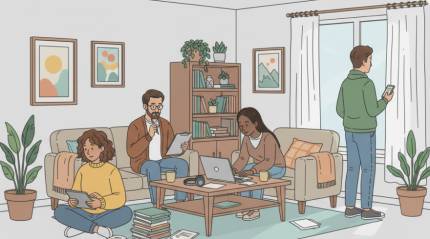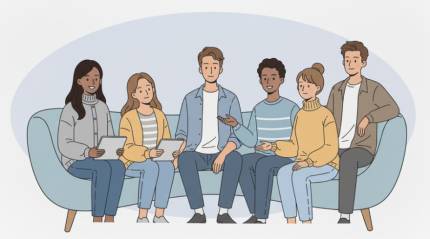Understanding Autism Screening for Adult Women: Clarity, Confidence, and Next Steps
- 20 October 2025

How Autism Presents in Adult Women
Autism can look remarkably different in women than in men, especially in adulthood. Many women become adept at masking or compensating for social and sensory differences, often blending into workplaces and communities while privately managing exhaustion, anxiety, or burnout. Traits might surface in subtle ways: an intense focus on niche interests, a preference for predictable routines, or delayed recovery after social events. Because these signs may be internalized, they’re frequently misinterpreted as shyness, depression, or perfectionism rather than considered through a neurodiversity lens.
Social scripts, learned eye contact, and meticulous planning may all help someone “pass,” yet this constant cognitive load can be draining. Some women report feeling out of sync, perfectly competent in structured environments, yet overwhelmed by unspoken rules or rapidly shifting expectations. When life transitions arise new jobs, caregiving responsibilities, or relationship changes, coping strategies can fray. In these periods of reflection, many individuals start exploring structured screening as a way to organize their experiences, and the autism test for adult women often becomes a meaningful gateway to self-understanding. The goal isn’t to label personality; it’s to identify patterns that can unlock better support, communication, and sustainable routines.
- Masking may reduce visibility of traits, yet it can elevate stress.
- Internalized challenges frequently get misattributed to other conditions.
- Life transitions often reveal longstanding sensory or social friction.
Why Screening Matters and the Benefits of Clarity
Screening tools act like a compass, not a final verdict. They help individuals translate day‑to‑day experiences into structured domains social communication, sensory processing, executive functioning, and flexibility. This shared vocabulary can make it easier to talk with family, friends, and healthcare professionals about needs that otherwise feel invisible. A thoughtful screening process also reduces self-doubt, replacing vague worries with targeted insights and practical adjustments at home or at work.
Beyond self-knowledge, early recognition of neurodivergent patterns can transform planning. People often report improved energy once they reshape routines, declutter commitments, and set clearer boundaries. These changes ripple outward: better sleep hygiene, slower social pacing, and intentional recovery time can sharpen focus and ease burnout. For many, taking an autism adult women test provides a structured nudge toward compassionate self-advocacy, enabling direct requests for reasonable accommodations, sensory-friendly environments, or communication preferences that make daily life far more manageable.
- Gain vocabulary to explain needs without apology.
- Identify reasonable adjustments to mitigate overwhelm.
- Spot co-occurring issues that warrant separate attention.
- Build a roadmap for professional evaluation if desired.
Common Screening Tools and How to Approach Them
Most self-screens are questionnaires that assess patterns across multiple domains. Some focus on social interpretation and reciprocity, while others emphasize sensory sensitivities, cognitive flexibility, or repetitive behaviors. The best approach is unhurried: respond based on typical, unmasked experiences rather than “ideal” behavior at your most energetic moments. If possible, complete the questions in a calm setting and revisit ambiguous items with a trusted friend who has seen you in varied contexts.
Format matters too, because clarity reduces second-guessing. When you compare available options, an adult female autism test will often present practical scenarios that reflect adult responsibilities, household routines, and workplace dynamics. Good tools avoid trick wording and provide clear scoring guidance, making it easier to interpret results without spiraling into worry. If you feel uncertain about specific items, keep a short note about what confused you; this becomes valuable context if you later speak with a clinician or counselor who understands neurodiversity in women.
- Answer based on everyday reality, not on “good days” alone.
- Pause if you feel overwhelmed, and resume when rested.
- Use notes to capture nuances that a questionnaire may miss.
- Compare tools that reflect adult roles and workplace demands.
Interpreting Results, Building Support, and Considering Next Steps
Scores and cutoffs are indicators, not identities. A higher score suggests more autistic traits, while a lower score suggests fewer but neither replaces a comprehensive clinical evaluation. Context is essential: trauma, chronic stress, ADHD, and sensory processing differences can influence responses, sometimes masking or mimicking autistic patterns. What matters most is using the output to guide practical changes, from renegotiating workload to designing sensory‑smart spaces at home.
Think of self-screening as an on-ramp to informed decision-making rather than a definitive endpoint. While online quizzes can be illuminating, a female adult autism test result should be viewed as a prompt for dialogue with a knowledgeable professional who can assess history, strengths, challenges, and co-occurring conditions. When you prepare for that conversation, bring concrete examples: meeting dynamics that drain you, textures that spike discomfort, or transitions that consistently derail your day. These details help clinicians map real-world impact to evidence-based frameworks.
| Aspect | Self-Screening | Clinical Evaluation |
|---|---|---|
| Purpose | Orientation and self-reflection | Formal differential assessment |
| Depth | Brief questionnaires and checklists | History, interviews, standardized tools |
| Outcome | Indicative score and insights | Diagnosis, recommendations, referrals |
| Limitations | Subjective reporting, limited nuance | Availability, cost, time to schedule |
| Next Steps | Adjust routines, gather examples | Plan supports, accommodations, follow-up |
- Document everyday patterns that align with your score.
- Explore peer communities to compare strategies.
- Consider occupational therapy for sensory ergonomics.
- Revisit screening after major life changes to recalibrate.
FAQ: Answers to Common Questions About Screening
How accurate are online screeners for adult women?
Online tools are designed to flag patterns worth exploring, not to deliver a diagnosis. Accuracy varies by instrument and by how candidly you answer. Results gain meaning when paired with real-life examples and, if you choose, a professional assessment that examines history, masking, and co-occurring conditions across your lifespan.
What should I do if my score is borderline?
Borderline results are common and still useful. Gather concrete scenarios, work meetings, social events, and sensory triggers, and notice recurring themes. With these notes in hand, you can decide whether to pursue a consult, refine your daily routines, or try targeted adjustments that reduce stress while you continue observing patterns over time.
Can a screening help with workplace accommodations?
Yes, a well-documented set of screening insights can inform discussions about reasonable accommodations. Start by identifying friction points such as noise exposure or rapid context switching. Then propose practical adjustments like quiet hours, written agendas, or asynchronous communication that align with your strengths and responsibilities.
Where can I find reputable tools tailored to women?
Many established instruments have adult-focused versions, and some platforms curate tools validated in diverse populations. For a broad starting point, platforms that host a autism test female adults often include guidance that explains scoring ranges and next steps, which can make conversations with clinicians and loved ones more straightforward. Always check whether a tool is backed by research and clear documentation.
Is self-screening still valuable if I’m not seeking a diagnosis?
Absolutely. The primary value lies in self-knowledge and practical improvements to daily life. You can use insights to fine-tune routines, reduce social overload, and optimize environments, even if you never pursue formal evaluation or labels. Clarity empowers you to prioritize energy and communicate needs with confidence.
How do I choose between different questionnaires?
Prioritize clarity, adult relevance, and transparent scoring. Tools that reflect your current roles partner, caregiver, team lead will surface the most actionable insights. Consider time to complete, item wording, and whether the results provide meaningful guidance for changes you can implement right away.
When should I revisit screening?
Reassess after significant life transitions such as job shifts, caregiving changes, or health events. Fresh screening can capture new stressors or improvements, helping you adjust routines before burnout accumulates. Treat it as periodic maintenance for your well-being rather than a one-time exercise.
Choosing Next Steps with Confidence
You deserve clarity that respects your lived experience. Thoughtful screening provides structure for reflection, language for advocacy, and a path toward sustainable habits that honor how your brain works. If insights resonate, consider sharing them with trusted allies and, if you wish, a clinician who understands women’s experiences across the spectrum. Whether you seek formal evaluation or simply refine your routines, steady, compassionate curiosity can make everyday life more workable and profoundly more you.
If you prefer to proceed gradually, explore reputable resources, compare formats that reflect adult responsibilities, and decide when to move from self-screening to a professional conversation. Along the way, remember that your strengths, pattern recognition, deep focus, empathy, and creativity are assets that can be amplified by environments designed with you in mind. Many readers discover that a measured, stepwise approach unlocks durable wellbeing without rushing the process or sacrificing authenticity, and an adult female autism test can be a thoughtful part of that journey toward clarity.



